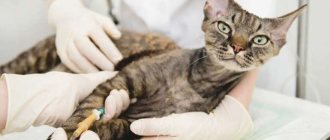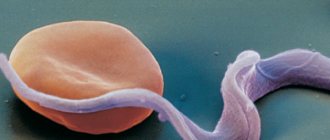Tumors of a malignant nature have been known for a long time, but they have become more often diagnosed in the clinical practice of veterinarians. This was provoked primarily by the fact that doctors now have the opportunity to early diagnose such pathological changes in the body.
Tumor processes lead among the diseases detected in cats and dogs. In cats, the vast majority of malignant tumors are found in the area of milk bags, soft tissue structures and bones.
Classification of lymphomas
There are several types of lymphoma in cats. The clinical picture, prognosis, and rate of progression of the pathology depend on the type of lesion.
Based on the location of the tumor, alimentary, mediastinal, and multicentric forms of lymphoma are distinguished, as well as lymphoma of visceral organs (kidneys, liver), lymphoma of the central nervous system, and skin. According to the morphology of the cellular composition: large cell and small cell lymphoma.
Alimentary form.
Typically the gastrointestinal tract and surrounding lymph nodes are affected. The leukemia virus is much less common in this type of lymphoma. It is the most common form of lymphoma in cats.
Mediastinal lymphoma.
The tumor is localized in the chest. Most often, leukemia virus is detected in cats, but there are patients in whom virological testing gives a negative result.
Multicentric lymphoma.
Characterized by damage to a large number of lymph nodes and multiple infiltration of internal organs. The disease is often associated with feline leukemia virus. The prognosis is quite bad. Detection of feline leukemia virus always worsens the prognosis.
Reasons for development
Veterinarians have not yet been able to establish the exact causes of lymphoma in cats. But they identify a number of provoking factors that increase the risk of pathology:
- Regular exposure to heavy metals or ionizing radiation.
- Unfavorable environmental conditions.
- Heredity and genetic predisposition. It is believed that the offspring of a cat that is subsequently diagnosed with lymphoma will most likely encounter this disease and its location will also be the same.
- The presence of leukemia virus in the blood, which is transmitted through blood or saliva. Its carriers are especially often homeless animals.
The impact of these factors causes changes in the genome of lymphocytes, as a result of which the process of cell division is disrupted and their uncontrolled reproduction begins with the formation of tumor neoplasms.
Signs
Clinical symptoms depend on the form of lymphoma.
Nutritional form:
- lack of appetite;
- lethargy, lethargy;
- vomit;
- diarrhea;
- constipation (constipation);
- weight loss.
Mediastinal form:
- dyspnea;
- difficult, rapid breathing;
- cough;
- loss of appetite;
- weight loss;
- decreased activity, lethargy.
Multicentric shape:
- enlargement, painful swelling of superficial lymph nodes (submandibular, axillary, inguinal);
- loss of appetite;
- weight loss;
- depression.
Other symptoms depend on which internal organs are involved in the pathological process.
Symptoms of the disease
At the onset of inflammation, the kitten exhibits the following symptoms:
- affected areas become hot;
- paired nodes that are close to the source of inflammation increase in volume;
- enlarged lymph nodes in the neck cause sore throat;
- loss of appetite, severe thirst;
- apathy: the animal constantly lies down, reacts poorly to stimuli.
When foci of inflammation are localized in the axillary, groin area, lameness is observed.
Diagnostics
The doctor conducts a complete physical examination of the patient and questions the owner in detail about the symptoms. If wheezing or pathological noises are detected during auscultation of the lungs, a chest x-ray is performed. The images, as a rule, clearly visualize tumor masses and free fluid.
If alimentary lymphoma is suspected, an ultrasound is performed - an examination of the abdominal cavity, which makes it possible to determine damage to the intestines and enlarged lymph nodes.
Mandatory laboratory diagnostics include general clinical and biochemical blood tests, cytological examination of aspirate obtained from puncture of altered lymph nodes. The puncture is most often taken from superficial lymph nodes. If the lymph nodes located in the abdominal cavity are enlarged, a percutaneous biopsy is performed. The doctor obtains very high-quality samples during diagnostic laparoscopy/laparotomy. In this case, a piece of altered tissue (intestinal wall) or the entire lymph node is taken for analysis. The material is sent for histological examination.
Cytological and histological examination is necessary for a final diagnosis. Only by identifying tumor cells under a microscope and describing their morphology in detail can you accurately determine what type of lymphoma your pet has and what chemotherapy regimen is most suitable for the patient.
Etiology of lymphomas in cats
At present, the causes of lymphoma in cats have not been precisely established. Most cancers arise as a result of a complex interaction of a number of factors on the process of normal growth and division of tissue cells, leading to a malfunction in their functioning and out of control of the body.
In many ways, the risk of developing lymphosarcoma in cats increases as a result of:
- exposure to various factors leading to immunodeficiency states (feline leukemia virus, feline immunodeficiency virus);
- ingestion of carcinogens (pesticides, tobacco smoke, etc.);
- reducing the overall resistance of the body (errors in feeding, poor living conditions, stressful situations, etc.).
In young cats (up to 3 years of age), a relationship has been proven between infection with feline leukemia viruses (FeLV) and immunodeficiency virus (FIV) and the appearance of lymphoma in the body in 60% of cases.
Treatment
Lymphoma is an extremely aggressive type of malignant tumor. To date, several basic chemotherapy regimens have been developed to achieve remission of the disease (disappearance of clinical signs, tumor infiltration for a certain time). The duration of treatment is usually 4-6 months.
If individual well-circumscribed tumor masses are identified in the intestine, surgical removal is indicated (especially when the tumor causes intestinal obstruction/obstruction). Radiation may be used for nasal lymphoma (tumor infiltrating the nasal passages).
A combination of surgery and chemotherapy is also used for certain indications.
Prospects
The prognosis for the diagnosis of feline lymphosarcoma depends on a large number of factors, the affected organs, the stage of the oncological process and the timeliness of treatment.
The average life expectancy of animals with lymphoma without an appropriate course of chemotherapy is 4-6 weeks.
If the tumor responds well to chemotherapy and there is a positive trend in the course of the disease, the animal's lifespan can be extended to an average of 3 years. In the presence of FeLV and/or FIV virus carriage, lack of treatment, as well as poor response of lymphoma to chemotherapy drugs, the prognosis may worsen to unfavorable.
Forecast
Depends on the cellular composition of the tumor (small cell lymphoma has an excellent prognosis), the severity of clinical manifestations, tumor location, the presence of leukemia virus or feline immunodeficiency virus (significantly worsens the prognosis), and individual response to chemotherapy.
Thus, in cats with small cell alimentary lymphoma and a good response to chemotherapy, the duration of remission was 2 years or more. Cats with large cell lymphoma respond less well to therapy, and death may occur within one month of diagnosis.
Cats with lymphoma of the central nervous system, kidneys, or bone marrow (rare tumors) respond poorly to treatment and have a poor long-term prognosis.
Stages of feline lymphoma
Piroplasmosis in cats: symptoms and treatment
From the onset of the tumor process to the death of the cat, there are 5 stages:
- the lymph node enlarges or a tumor appears in an internal organ;
- extranodular neoplasm invades adjacent lymph nodes. A tumor grows in the gastrointestinal tract. On one side of the diaphragm, 2 extranodular neoplasms appear;
- Tumors grow on both sides of the diaphragm, affecting 2 lymph nodes. The third stage includes any neoplasms in the spinal cord or abdominal cavity;
- damage to the spleen or liver;
- damage to the central nervous system or bone marrow. Terminal stage.
Important! The tumor process is inexorably and rapidly progressing, so treatment should be started as soon as possible.
Prevention measures
Prevention, proper, proper care of the cat will prevent lymphadenitis and reduce the risk of the pet contracting dangerous viral-bacterial and parasitic diseases.
Prevention measures:
- Timely vaccination, revaccination;
- Balanced diet;
- Reducing contact with street animals;
- Strengthening the immune system with vitamins and mineral complexes with a natural diet.
- Systematic inspection.
- Timely treatment of inflammatory processes, systemic, viral, bacterial diseases;
- Treatment against ecto-endoparasites.
Functions of lymph nodes in a cat's body
Lymph nodes are an important part of the lymphatic system in the body of our smaller brothers. They are peripheral organs of the lymphatic system.
Functions of lymph nodes in a cat’s body:
- Protective. Lymph nodes are a kind of barrier that prevents foreign agents and bacteria from penetrating other organs and systems of the body.
- Conductive (homepoietic). Conducting lymph from tissues into the venous bed.
- Immune, activation of the immune response. Lymph nodes contain T- and B-lymphocytes - cellular structures that form immune defense.
Thus, the main function of lymph nodes is a biological filter. Lymph flows through them, which comes from the internal organs and systems of the body.
Depending on their location, lymph nodes are classified into: regional (submandibular, inguinal, occipital), superficial (located above the fascia) and deep (subfascial).
Varieties
Histologically, B and T cell lymphosarcoma are distinguished. The following forms are classified according to clinical symptoms:
- Mediastinal.
- Plural.
- Nutritional.
- Extranodal.
- Lymphocytic leukemia.
Most types of lymphoma affect middle-aged and older cats.
Based on the shape of the flow, they are distinguished:
- Indopeent. The disease progresses indolently, with adequate treatment the prognosis is good.
- Aggressive. The pathology develops rapidly, the prediction is doubtful.
It's not easy to get sick
Prognosis based on the results of therapy
The prospect of prolonging the life of a cat with lymphoma depends on at what stage of the disease treatment was started, which organs are affected by the tumor, and on the correctly selected chemotherapy regimen. According to statistics, 67–69% of patients tolerate chemotherapy well, and their life expectancy increases to six months. Complete remission is observed in 38% of animals and gives them an extra 3 years of life. If an individual negative lymph reaction to chemotherapy occurs or the disease is viral in nature, the animal will not survive.
If treatment is not carried out or is prescribed for a severe form of the disease, the doctor’s prognosis for a four-legged patient is no more than 6 weeks of life. The outcome is sad, but the owners do not despair. Many cat owners, faced with such a serious problem, fight to the end for the life of their pet: they follow all the doctor’s recommendations, support the pet’s mood, and create the most optimal living conditions for it.
Symptoms
Pathological foci can occur everywhere where there are blood vessels containing modified lymphocytes. With almost all types of Lymphoma, the cat loses activity and loses a lot of weight. The tumor most rarely affects the brain, because the blood-brain barrier is an insurmountable obstacle for the virus.
In the latter situation, the cat experiences nervous phenomena accompanied by paralysis. The prognosis is unfavorable. In other cases, the following signs of Lymphosarcoma are observed:
- Difficulty breathing.
- Nutritional sarcoma.
- Multiple lymphoma.
- Paralysis.
- Rhinitis.
- Anemia.
Difficulty breathing
A characteristic sign of mediastinal lymphosarcoma. In place of the thymus gland, an extensive tumor forms, compressing the lungs.
The cat takes a forced position that facilitates breathing movements - it stretches its neck and tries to take a convulsive breath.
Nutritional sarcoma
With this type of Lymphoma, the following pathological symptoms are observed:
- Constipation. Caused by a developing tumor. Promotion of digestive products is difficult. In severe cases, the intestine becomes blocked by a neoplasm or is compressed by a tumor developing in the abdominal cavity. In such a situation, immediate surgical intervention is indicated.
- Vomit. It is a consequence of constipation. The slow movement of chyme through the alimentary channel is accompanied by the development of putrefactive microflora, the excretion products of which cause intoxication. The body tries to fight by increasing peristaltic as well as anti-peristaltic movements.
Vomit
Multiple lymphoma
The pathology is manifested by hypertrophy of the lymph nodes throughout the body. A thorough examination reveals an enlargement of the spleen, as well as the liver and other internal organs.
Paralysis
If the tumor forms near the spine or in close proximity to the spinal cord, the nerves responsible for performing movements of the limbs are blocked. The cat is paralyzed.
Rhinitis
A runny nose, as well as discharge from the nose and eyes, are symptoms of Feline Immunodeficiency. Local lymph nodes become hypertrophied. The pet sneezes and rubs its face with its paws. The discharge may be foul-smelling and multi-colored.
Runny nose with purulent discharge
Anemia
All types of lymphosarcoma occur with signs of anemia. The concentration of leukocytes deviates from the norm in any direction. Symptoms of hypoplastic anemia develop.
What is lymphadenitis
Lymphadenitis is an inflammation of the tissues of the lymph nodes, which is accompanied by an increase in their size due to an increase in the number of lymphocytes and the migration of leukocytes into them. In animals, as in humans, the inflammatory process in the lymph nodes develops due to primary inflammation of a specific localization.
Important! In some cases, lymph nodes can become a source of infection if suppuration develops in them.
Causes of lymphadenitis in cats:
- acute, chronic viral, bacterial, parasitic infections;
- weakening of immunity, resistance;
- respiratory diseases (rhinitis, sinusitis, bronchitis, laryngotracheitis, sinusitis, tonsillitis);
- neoplasia (malignant tumors that metastasize to the lymph nodes);
- lymphoma (cancer of the lymph nodes);
- failure to comply with hygiene rules;
- autoimmune infections;
- herpes virus;
- mycoses;
- connective tissue diseases;
- allergic reactions, allergies of various etiologies;
- injuries, penetrating wounds through which pathogenic microorganisms penetrate tissues and internal organs.
Inflammation can be provoked by blood-sucking parasites (fleas, ticks, lice eaters), endoparasites (worms), while damage to the lymph nodes by the inflammatory process during parasitic infections is less common.
In general, lymphadenitis is a protective, defensive reaction of the body that is not life-threatening for the pet as long as the lymph is not affected.
Forms of lymphadenitis
Lymphadenitis in pets occurs predominantly in an acute form, less often in a chronic form, each of which has its own causes of development and symptoms.
Forms of lymphadenitis by reason and nature:
- viral, bacterial;
- traumatic;
- catarrhal;
- fibrinous;
- hemorrhagic;
- purulent;
- cancer (malignant tumors);
- nonspecific, which is caused by a decrease in the immune potential of the body after infections or damage to the skin.
Important! The most life-threatening form of lymphadenitis for cats is the purulent form. If treatment is not started, the pus melts the capsule of the node, leading to the formation of an encapsulated abscess. Sepsis may develop, which can be fatal.











